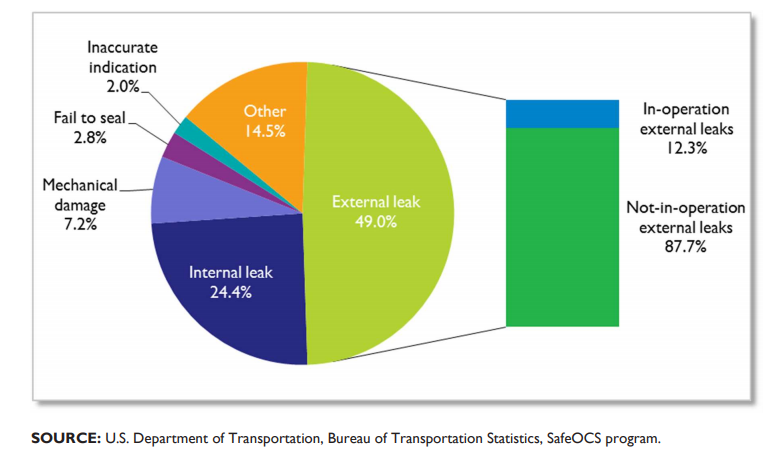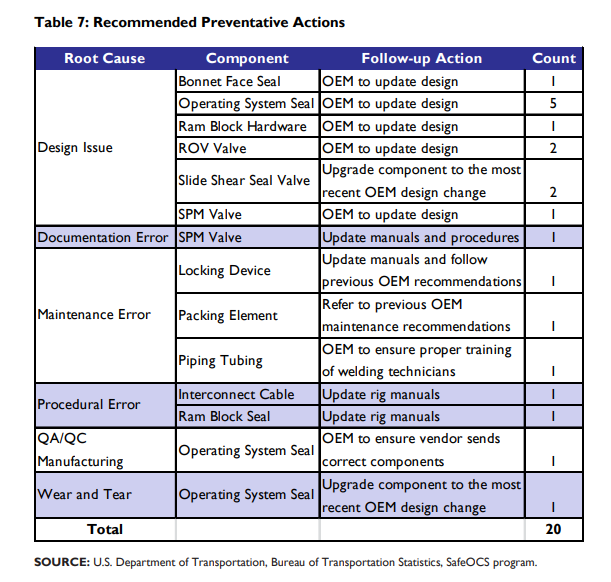Through its SafeOCS program, the US Bureau of Safety and Environmental Enforcement released its annual report Blowout Prevention System Safety, informing that through 2017, 18 of 25 operators associated with rig operations in the Gulf of Mexico reported 1,129 equipment component failure events, which represents an overall decrease from 2016.
Key findings
- The reported events occurred on 45 of the 59 rigs operating in the GOM during this period.
- Based on information sent to BSEE, the 18 reporting operators account for 90.2% of new wells drilled.
- Both types of BOP stacks (subsea and surface) were associated with component failures and the majority of notifications were associated with the more complex subsea BOP stacks (92.5%).
- The top four reporting operators represented 81.8% of reported component events and 32.7% of new wells spud in the Gulf of Mexico for 2017.
- There was a decrease in overall reporting from 2016 to 2017. The event reporting rate adjusted for rig activity (defined as events per 1,000 BOP days) decreased from 122.3 in 2016 to 59.8 in 2017.
- There was an increase in reporting equipment component failures while not in operation for rigs with subsea BOP stacks. The percent of subsea, not-in-operation reports for 2017 was 86.4 as compared to 79.8% for 2016.
- There was a decrease in the rate of unplanned stack pulls for rigs with subsea BOP stacks. In 2016 the rate was 7.2% and in 2017 it was 5.6%.
- Based on follow-up documents submitted to SafeOCS, only 12 of the 18 components involved in unplanned stack pulls were sent to shore for further analysis by the original equipment manufacturer (OEM) or a third party, despite the expectation of a root cause failure analysis (RCFA) for every stack pull.
- Of 1,044 subsea events in 2017, one reported loss of containment of synthetic oil base mud (drilling fluid) during in-operation rig activity. No surface stack events resulted in loss of containment.
- Leaks remained the most frequently reported observed failure and wear and tear remained the most frequently reported root cause of failure events in 2017 as they were in 2016.

Lessons learned
The table below shows follow-up actions resulting from RCFAs and confirmed in documentation submitted to SafeOCS. For example, 5 follow-up actions reflected design updates to the operating system seal.
Reported follow-up actions included mitigation steps to improve training, documentation, and/or equipment source accuracy; equipment design changes; or long-term corrective actions for the OEM, operator, and/or equipment owner.
Although there was limited information on learnings from RCFAs reported in 2017, the listed actions serve as examples on how RCFAs lead to improvements not only for an individual entity, but also for the entire industry. If the OEM discovers the need for an updated design of a component, this update will be implemented across the industry to prevent a reoccurring failure, which reduces risk and improves operations. Since design issues can span across industry, a more in-depth review of notifications indicating design issue as the root cause is warranted.
In 2017, 80 notifications listed design issue as the root cause and the affected component failures included: annular packing element seal failure, BOP ram door hinge seal leakage, Belleville spring corrosion or cracking, insufficient ball valve mounting bolts loosening, SPM seal plate scoring and cracking, choke and kill valve gate/seat cracking, and BOP ram retraction issues. Of these 80 notifications, further investigation and analysis were completed for 9, and 30 are still pending.

Further details may be found herebelow:































































